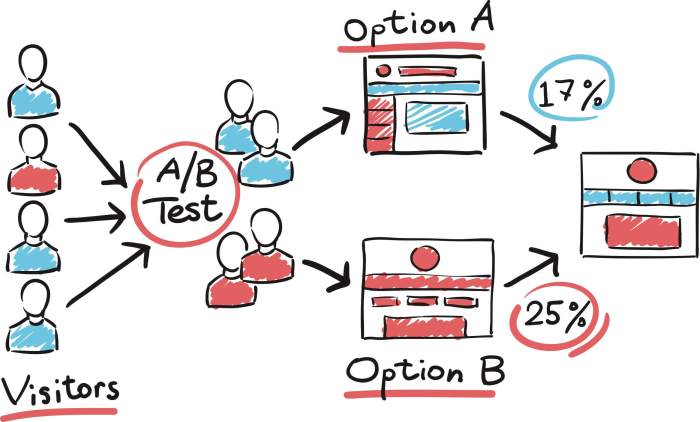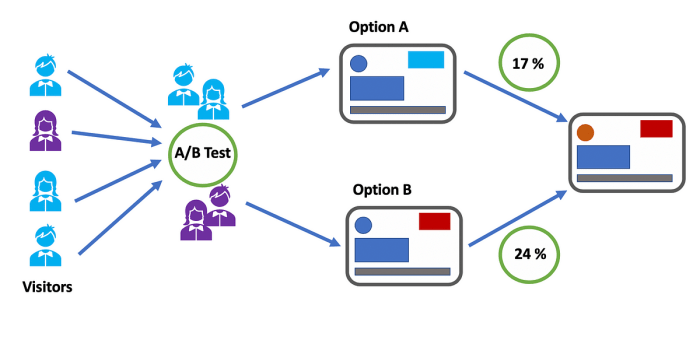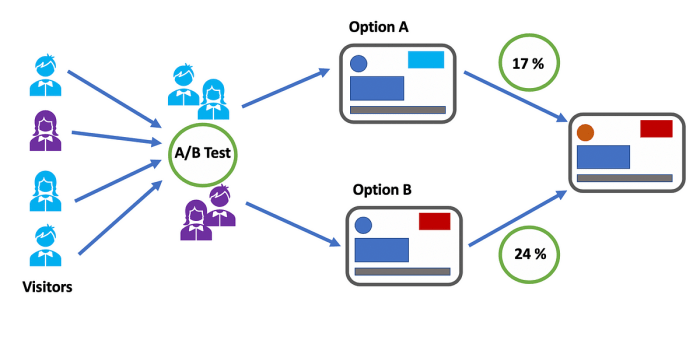A/B Testing in Marketing is all about finding the winning formula to make your campaigns stand out. From defining the process to analyzing the results, get ready to dive deep into the world of marketing experimentation.
Introduction to A/B Testing in Marketing

A/B testing in marketing involves comparing two versions of a webpage, email, ad, or other marketing asset to determine which one performs better. This method allows marketers to make data-driven decisions and optimize their strategies for better results.
Importance of A/B Testing in Optimizing Marketing Strategies
A/B testing is crucial in marketing as it helps identify what resonates best with the target audience. By testing different elements such as headlines, images, or call-to-action buttons, marketers can understand consumer preferences and tailor their campaigns accordingly. This leads to improved conversion rates, higher engagement, and ultimately, increased ROI.
- A/B testing provides valuable insights: By testing different variations, marketers can gather data on what works and what doesn’t, enabling them to make informed decisions.
- Optimizing performance: Through A/B testing, marketers can refine their strategies to enhance the effectiveness of their campaigns, leading to better results.
- Cost-effective experimentation: A/B testing allows marketers to experiment with different ideas without investing significant resources, helping them refine their approach without breaking the bank.
Examples of Successful A/B Testing in Marketing Campaigns
-
Changing the color of a call-to-action button: By testing different colors, a company discovered that a red button resulted in a 21% increase in clicks compared to a green button.
-
Testing email subject lines: A/B testing showed that using personalization in the subject line led to a 15% higher open rate than generic subject lines.
-
Optimizing landing page layout: Through A/B testing, a business found that a simplified layout with a clear value proposition increased conversions by 30%.
Setting Up A/B Tests

When it comes to setting up A/B tests in marketing, there are a few key steps to follow to ensure accurate and reliable results. First, you need to clearly define your objective and what you want to test. This could be anything from testing different versions of a website landing page to different email subject lines.
Selecting Variables to Test
- Choose variables that directly impact the outcome you are testing. This could include elements like headlines, images, call-to-action buttons, or pricing.
- Avoid testing too many variables at once, as this can muddy the results and make it difficult to determine what caused any changes in performance.
- Ensure that the variables you choose to test are relevant to your target audience and align with your overall marketing goals.
Ensuring Statistical Significance, A/B Testing in Marketing
- Set a clear hypothesis before running the test to determine what you expect the outcome to be.
- Ensure that you have a large enough sample size to make statistically significant conclusions. A sample that is too small may not accurately reflect the larger population.
- Use statistical tools to analyze the data and determine if the results are statistically significant. This will help you make informed decisions based on the test outcomes.
Best Practices for A/B Testing
When conducting A/B tests in marketing, it is crucial to follow certain best practices to ensure accurate results and actionable insights. Randomization plays a key role in A/B testing, as it helps in eliminating bias and ensuring that the test results are statistically significant. Additionally, avoiding common pitfalls can help in maximizing the effectiveness of A/B tests.
The Importance of Randomization in A/B Testing
Randomization is essential in A/B testing as it helps in reducing the impact of external factors that could skew the results. By randomly assigning users or samples to different variations, you ensure that each group is representative of the overall population. This helps in drawing valid conclusions and making informed decisions based on the test results.
Tips to Avoid Common Pitfalls in A/B Testing
- Ensure an Adequate Sample Size: Having a sufficient sample size is crucial to obtain reliable results. A small sample size can lead to skewed or inconclusive results.
- Set Clear Goals and Hypotheses: Define clear objectives and hypotheses before conducting the test to ensure that you are measuring the right metrics and variables.
- Avoid Interpreting Noise as Signal: Be cautious of drawing conclusions based on insignificant fluctuations in data. Focus on statistically significant results.
- Monitor Results Regularly: Keep track of the test results throughout the duration of the test to identify any anomalies or issues that may arise.
Analyzing A/B Test Results
When it comes to analyzing A/B test results, it’s crucial to do so effectively in order to make informed decisions for your marketing strategies. By understanding how to interpret the data and determine the significance of the results, you can confidently move forward with the winning variation. Here’s how you can analyze A/B test results like a pro:
Interpreting Test Results
- Look at the overall conversion rates for each variation to see which one performed better.
- Consider statistical significance to determine if the results are reliable and not due to random chance.
- Analyze secondary metrics such as bounce rate, time on page, or click-through rate to get a comprehensive view of performance.
Determining Significance
- Calculate the p-value to see if the results are statistically significant (typically p < 0.05 is considered significant).
- Consider the confidence interval to understand the range in which the true difference between variations lies.
- Take into account the sample size to ensure that the results are based on an adequate amount of data.
Making Data-Driven Decisions
- Use the insights from the A/B test results to inform future marketing campaigns and strategies.
- Implement the winning variation on a larger scale to maximize the impact on your target audience.
- Continue testing and iterating based on data to optimize your marketing efforts over time.






